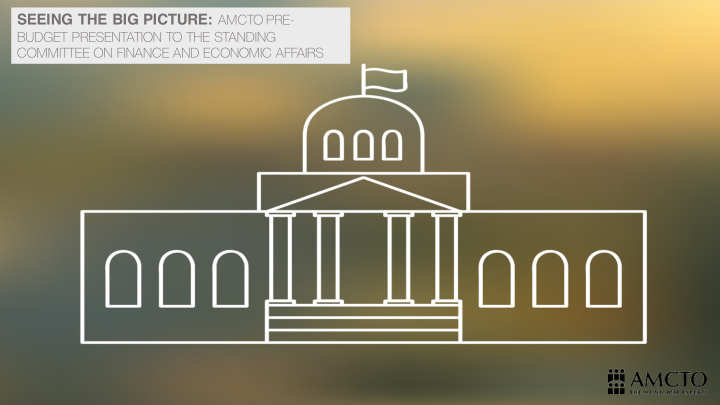



SEEING THE BIG PICTURE: AMCTO PRE- BUDGET PRESENTATION TO THE STANDING COMMITTEE ON FINANCE AND ECONOMIC AFFAIRS
AMCTO | BACKGROUND • 2,200 members located in almost every municipality in Ontario • Ontario’s largest voluntary association of local government professionals • Dedicated to providing management and leadership services to local government professionals through learning opportunities, member support, and legislative advocacy • Work in partnership with AMO and many other municipal associations
AMCTO | MEMBERSHIP BREAKDOWN CAOs, 13% Legislative Services, 31% Managers Finance, 23% (various dep'ts), 33%
PRINCIPLES FOR AN EFFECTIVE PROVINCIAL-MUNICIPAL RELATIONSHIP 1. Respect for municipal diversity 2. Treating municipalities as responsible orders of government 3. Legislating outcomes and not behaviours
RECOMMENDATION 1 | Take the lead on a regulatory approach for the sharing economy • Sharing economy companies, like Uber and AirBnB, have grown to become dominant forces in our economy • 45% of Canadians are willing to rent their belongings to others, and 42 percent are willing to rent from others • Uber operates in 67 countries and over 371 and cities • AirBnB has more than 2 million listings in over 34,000 cities, in 190 countries
RECOMMENDATION 1 | Take the lead on a regulatory approach for the sharing economy Uber Use in Toronto November 2014—December 2015 (Have you used the Uber ride sharing mobile app?) Never heard of Uber No Yes 8% November (2014) 80% 12% 6% April (2015) 76% 17% 4% July (2015) 74% 22% 0% December (2015) 72% 28% Source: Forum Research Inc., “Uber use continues to climb; satisfaction high,” December 29, 2015
RECOMMENDATION 1 | Take the lead on a regulatory approach for the sharing economy Public Preferences on How to Regulate Uber (Which of the following is the best solution to this dispute?) 34% 30% 17% 7% 7% 6% Banning Uber Regulating Uber just like taxis Loosening regulations for Deregulating the taxi industry Something else Don't know are regulated now taxis to compete with Uber Source: Forum Research Inc., “Uber use continues to climb; satisfaction high,” December 29, 2015
RECOMMENDATION 2 | Continue to invest in infrastructure • The infrastructure deficit is perhaps the most significant fiscal pressure facing municipalities • Local governments in Ontario own more infrastructure than any other level of government, including more than 140,000 kilometres of roads, and 15,000 bridges and large culverts • 2016 Canadian Infrastructure Report Card found that 1/3 of municipally-owned infrastructure in Canada is at risk of rapid deterioration • In 2008 the infrastructure deficit was estimated to be approximately $60 billion, not including parks and recreation facilities or social housing units, which were valued at an additional $40 billion
RECOMMENDATION 2 | Continue to invest in infrastructure Federal, Provincial, and Municipal Asset Ownership, 1961—2005 (excluding provincially-owned infrastructure dedicated to education and healthcare) Local Provincial Federal 67% 38% 31% 31% 22% 10% 1961 2005 Source: Association of Municipalities Ontario (AMO), What’s Next Ontario? Imagining a prosperous future for our communities, 2015, 23
RECOMMENDATION 3 | Modernize and streamline regulation and provincial reporting • Local government’s in Ontario are drowning in regulation and unnecessary reporting • More than 70 pieces of provincial legislation that affect the municipal sector – countless regulations • Municipalities are responsible for a variety of cumbersome reporting requirements, like financial reporting, performance measurement, compliance reporting for fiscal transfers and conditional grants, and audits and evaluations of provincially mandated programs • Digital technology and open data, and smart regulation provide potential opportunities to lessen the reporting and regulatory burden for municipalities
RECOMMENDATION 4 | Invest in capacity building and succession planning in rural, remote and northern municipalities • Northern, rural and remote municipalities face an additional challenge of attracting and maintaining qualified municipal staff • Demographic changes more significant for the public sector • Retirements offer exciting opportunities for new professionals to enter the sector, but also result in a loss of accumulated knowledge, expertise, and experience • AMCTO has prioritized this work through the Municipal Management Internship Program and the ONWARD initiative
RECOMMENDATION 4 | Invest in capacity building and succession planning in rural, remote, and northern municipalities Projected Municipal Staff Retirements (How long do you have until your anticipated retirement date?) 21% 19% 19% 18% 12% 8% Less than 2 2-5 years 6-10 years 11-15 years 16-20 years More than 20 years years Source: AMCTO, State of the Membership Survey, 2015
RECOMMENDATION 4 | Invest in capacity building and succession planning in rural, remote, and northern municipalities Projected Municipal Staff Retirements (How long do you have until your anticipated retirement date?) 13% More ¡than ¡20 ¡years 19% 14% 16-‑20 ¡years 12% 22% 11-‑15 ¡years 18% 17% 6-‑10 ¡years 19% 24% 2-‑5 ¡years 21% 9% Less ¡than ¡2 ¡years 8% The ¡North General Source: AMCTO, State of the Membership Survey, 2015
RECOMMENDATION 5 | Give municipalities access to new revenue tools • Local governments in Ontario facing a fiscal squeeze • Concerned about their ability to continue providing high-level services to their citizens • Despite expansion of responsibility, municipalities have access to limited sources of revenue
RECOMMENDATION 5 | Give municipalities access to new revenue tools Projected Ontario Municipal Operating Costs to 2020 (in millions) 2020 (Projected) $45,318 2015 (Projected) $40,329 2009 (Actual) $33,968 Source: Association of Municipalities Ontario (AMO), What’s Next Ontario? Imagining a prosperous future for our communities, 2015, 23
RECOMMENDATION 5 | Give municipalities access to new revenue tools Ontario Municipal Expenditures, by Service Area 2014 Planning/ Development, 2% General Gov't, 5% Recreation/Cullture, 10% Protection Services,18% Social Services (including housing), 22% Transportation, 24% Health/Emergency Services, 5% Environmental Services,15% Source: Ministry of Municipal Affairs and Housing, Financial Information Returns, 2014
RECOMMENDATION 5 | Give municipalities access to new revenue tools Sources of Municipal Revenue, 2013 Other Revenues, 14.40% Licenses and Property Taxes, Permits, 2.60% 41.70% Transfers,21.30% User Fees,19.90% Source: Ministry of Municipal Affairs and Housing, Financial Information Returns, 2013
Recommend
More recommend